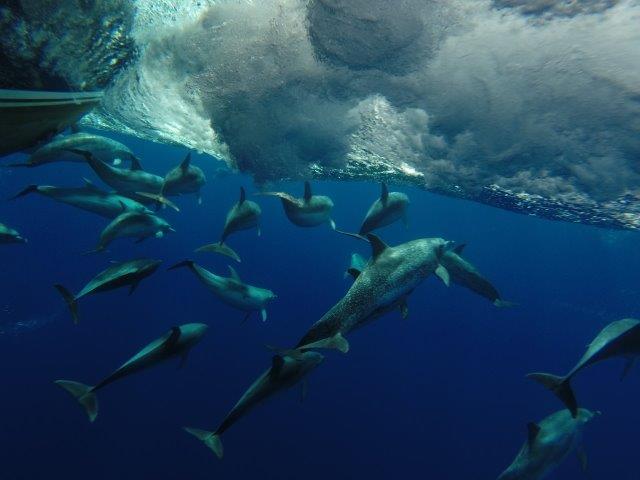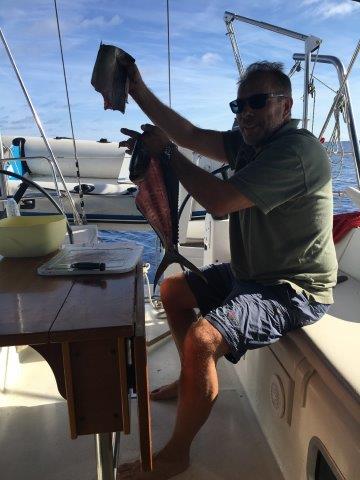With almost 300 boats in the ARC fleet spread from Las Palmas de Gran Canaria to Saint Lucia, Marine Ecologist Isabella Tortora Brayda explains what marine wildlife they may encounter in the North Atlantic.
Dolphins and Whales
Of all the oceanic species, some of the most fondly regarded, graceful and magnificent, are the whales and dolphins (cetaceans). Many of the species are migratory, such as humpback whales, and explore the length and breadth of the ocean, from warmer breeding grounds at low latitudes before migrating to feeding grounds at high latitudes. They can reach an impressive size, facilitated by the pressure of the water column, which provides support for the internal organs and helps with blood circulation.

There are pods of cetaceans scattered all across the Atlantic, and a transatlantic crossing wouldn’t be complete without a sighting. Whale and dolphin sightings are more common in the deep mid ocean waters. Some relatively common whale species to look out for are humpbacks, short-finned pilot whales, and sperm whales. Despite their huge size it can be surprisingly easy to miss the approach of one of the gentle giants if you are not alert to the signals of its presence. Keep your ears open for the soft puff of a blow as they surface and scan the horizons for areas of aggregated diving gannets. The diving seabirds can be a sign of where a pod of whales has herded a school of fish close to the surface and a feeding frenzy of all different marine species has begun. If you sight a whale and would like to approach it, do so slowly and respectfully. The WiSe Cetacean Code of Conduct suggests a steady approach no faster than 6 knots from a kilometre away. Give the cetacean a wide berth and don’t approach closer than 100m. Just let it come over to you, if it’s feeling curious.
The playful and curious dolphin has a tendency to swim in the wake and at the bow of the boat as it acts much like the wave machines we use for surfing practice. Some of the most common species to look out for are the bottlenose and common dolphins, Atlantic spotted dolphin and rough-toothed dolphin.
For more information about different species of whales and dolphins and where they live, check out the Whale and Dolphin Conservation website (
www.wdcs.org).
Fish to FishRecreational fishermen on yachts crossing the open ocean can aspire to catch fresh tuna, king mackerel, dorado and occasionally swordfish. Success rates vary and bigger does not always mean better when choosing lures. Bigger lures will attract bigger fish, but unless you have a large crew on board, a big fish flopping about on deck is hard to control and can cause a fair bit of damage!
There are so many different types of lures and all have different circumstances under which they work best. In the tropics blues, pinks, whites and reds are effective. When laying out a length of line make sure the lures aren’t too close to the wake of the boat as it will hide them, too far beyond the wake is too still and less likely to attract anything. Once you have a bite it helps to slow the boat.

The transition of the fish from the line to the deck can be a mission and it’s useful to have a strong gaff, alcohol in a spray bottle and gloves to hand. The gaff can be used to stab and lift the fish on deck. Holding the fish by its tail and spraying alcohol on the gills is generally the easiest method of dispatch if it is destined for the table. Gloves are necessary to prevent slicing your hands on the wire leader of the razor like teeth of these top predators.
When crossing the tropics, it’s quite likely that an occasional flying fish will serve itself on a platter for you, throwing itself on board at night. If you shine a light on deck it tends to attract them, but there are no guarantees there will be enough for a full meal.
Yachting World has some useful tips for Bluewater fishing:
- It’s worth taking spare parts as the reels can take a lot of punishment
- A gaff is very useful for getting the fish on board
- the optimal window for fishing is two hours after sunrise and two before sunset
- attach a leader and a swivel before the lure
- DIY lures are possible to be made out of rubber gloves
- Use thick enough line for the fish you hope to catch
In the Caribbean it is advisable to avoid fishing around reefs as there are higher levels of a toxin called Ciguatera. It collects in fish feeding on algae on the coral reefs and leads to unpleasant symptoms for humans that can have long lasting effects. Generally the southern islands, from Guadeloupe south are considered safe to fish, but if in doubt ask a local. Other areas, such as the British Virgin Islands have restrictions on fishing with rods or spear-guns, and permits are required.
Turtles
Sea turtles are part of an ancient family that has been on the planet for 200 million years! Most migrate between feeding grounds and breeding grounds covering hundreds to thousands of miles. Some of the best nesting sites are around the coasts of the America’s, namely Florida and Costa Rican beaches. There are turtle several species of turtle in the Atlantic including the green turtle, hawksbill, leatherback, Kemp’s Ridley turtle and the most common species, the loggerhead turtle.
Loggerhead turtles have large heads with very strong jaws that they use to crunch through crustaceans. Jellyfish make up a large portion of their diet too, which unfortunately share a close resemblance to plastic carrier bags washed out to sea. This doesn’t generally play out well for the Loggerhead and they are an endangered species. They are also prone to becoming entangled in rubbish and fishing lines.
Green turtles were once common in the Atlantic waters but when turtle soup became popular in the early 1900’s, their population declined notably. Conservation efforts have been successful in promoting recovery and there are large populations in West Africa, Costa Rica and Ascension Island. The green is the second largest turtle species (the leatherback is the largest), reaching 1.5m long and weigh 200kg!
If you find yourself in the water with sea turtles, you will find them very friendly and they will act as though they are part of your swimming group. Be careful though as they do have a beak capable of nipping you if you get on their nerves and make sure you don’t hold onto their shells as they swim as they too as they may be on route to the surface to breathe!
Sharks and Stingrays
Despite their noticeable differences (one having lots of teeth and the other being very flat), sharks and rays actually belong to the same family: cartilaginous fish. They don’t have a skeleton in the same way we do. Instead their skeleton is made of cartilage, the same stuff we have supporting our ears and noses.
The Atlantic is home to 40 foot whale sharks through to 7 inch pygmy sharks. There are great whites and hammerheads as well as the Atlantic sharpnose shark. Sharks have a bad reputation as savage human hunters, but are really rather misunderstood creatures. Yes they do have a scary number of teeth and cold, dead looking eyes, but the number of shark attacks is surprisingly few – an average of only 100 year with only 10 fatalities.
Rays to look out for are the common, round and roughtail stingrays, as well as eagle rays, butterfly ray and marbled electric ray in the Atlantic. Although they are armed with a rather nasty sting on the tail, aggressive behaviour of stingrays to humans is generally rare.